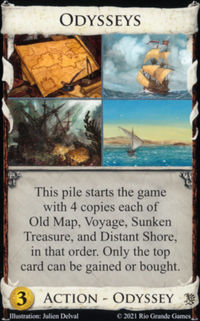
So far most discussion on this board has concerned itself with a single card, but unless these cards come from Black Market they are never seen without each other so this is not a relevant way to assess the cycle. This (almost) always exists as a group of 4 cards that like most cycles has built in combo potential so in order to consider the value of these cards I am viewing them as a set. Odyssey is probably the most tactically complex card pile in dominion. It leads to a large number of non-trivial decisions the player must make and can combo with a very large number of outside cards due to including action, treasure, and victory card types and being gaining, card draw, card selection, and extra turns all in one pile.
Letís start with the top card,
Old Map.
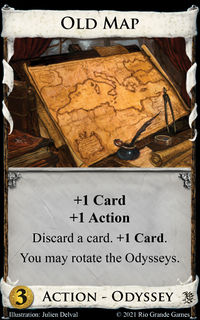
Old Map as the top card is uniquely able to rotate the Odyssey pile. However this may not be a very significant advantage in many cases as you will have the same cards available in your buy phase that your opponent will have in their next turn. If you are taking Old Map strictly to get to the cards underneath it you may be putting yourself at a disadvantage. This ability becomes highly relevant if you have the ability to rotate the pile and gain the next card and then rotate it again before your opponentís next turn but that is often to difficult to set up.
Comparing this card to a silver for your first shuffle 3 buy, it makes it less likely that you will hit $5 or even $4 but it will often scale better later into the game where the card selection is more useful. This card is designed to combo with
Distant Shores by making the extra estates less likely to hurt you.
As far as cards outside of Odysseys go, this card is great to combine with Tunnel, Village Green or anything else you want to discard. It gives a decent ability to filter cards so it is more powerful when no trashing is present.
Old Map also has the distinct advantage of allowing you to pull through your entire deck on the T3-T4 shuffle. Usually a player will bottom deck two cards which can be a significant issue when something important like
Peasant ends up on the bottom of the deck but Old Map allows you to draw two cards extra cards and go through all 12 in two turns. The only reason it will not do this is if it itself is on bottom deck. However the chance of your Peasant or other important card and Old Map both being on bottom is 1 in 66 down from a normal 1 in 6 chance you donít play that Peasant.
Next up we rotate over to
Voyage.
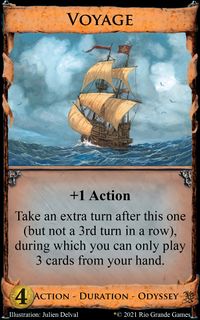
Voyage is a very unique card that allows you to take extra turns but limits the number of cards you can play on those turns. Voyage has a distinct weakness with card draw of any kind as playing card draw during a voyage turn means gaining cards you canít play most of the time. It becomes more powerful when combined with cards like attackers or gainers that generate value simply from playing a single card, and it especially works well with the next card in this cycle
Sunken Treasure!
Voyage has a bit of a love hate relationship with other durations. Playing
Caravan on your main turn only to draw extra cards you canít play isnít very helpful but the possibility of setting up a duration in a voyage turn is quite useful as are durations that may help you in other ways during your Voyage turn such as
Merchant Ship making it much more likely you can buy a bigger card or even province during a voyage.
Next up we have
Sunken Treasure.
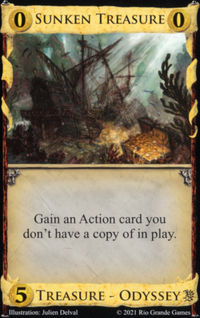
Naturally this card works well with Voyage as it is a gainer like Voyage wants and it itself becomes less useful the more cards you play. It also helps you to gain
Distant Shores quickly as soon as it is uncovered for substantial VP.
Sunken Treasure has no pricing restrictions making it better when expensive or oddly coated actions are on board. It can gain Golem, Possession, City Quarters, or Overlord for a single treasure play. It also benefits from cards that do not stay in play and trashers. For example Experiment or Acting Troupe will never be in play during your buy phase since they return and trash themselves. With Experiment this means you can usually use Sunken Treasure as a Sleigh that doesnít cost an action if you canít gain a more useful card.
The gaining becomes more useful with trashers with upsides as well. For example with Grave Robber you may be gaining a 5 cost simply to trash it into a province. If that card is only being trashed it wonít be in play meaning each Sunken Treasure can gain one of those cards.
This card also benefits from anything that lets you play treasure in your action phase as you may then play it before other actions such as by using
Storyteller.
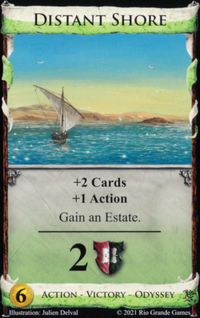
The final card in the cycle
Distant Shores may be the most complicated of all. This card combos with the filtering from maps to draw more cards but cycle out the bad ones, and Sunken Treasure helps you gain it despite its high price. However most the discussion around it was about how it was bad because it gains estates. However it is a lot more complicated than that and gaining estates can even be an upside! Outside of obvious things that combo with estates like Shepherd, Inheritance and Silk Road, this card can be used to trigger a 3 pile end game quicker by emptying the Estate pile. When you consider that all Distant Shores and the 8 estates is a total of 16 VP using this to end the game when other piles are low can be a great strategy.
In order to consider the consequences of playing this card I evaluate a dead card, in this case an estate, as -1 cards since it wastes a draw. This is not necessarily true as seen with the Old Map giving you the potential to discard them and draw a new card but it is a relevant way of thinking about it. Distant Shores itself is +1 cards that then gives estates each worth -1 cards. This means your first shuffle with a Distant Shores you have an advantage if you play it, and your second shuffle should be neutral since you now have one more estate. There are a total of 8 supply estates so if players are gaining all distant shores there are at most 2 estates to gain per Distant Shores. This leads to having a +1 card from distant shores and -2 from two estates on average betting -1 card and +4 VP. According to this model a Duchy is -1 card and 3VP. This can be made better with old maps or anything that gives a use to the estates though as they are no longer a full -1 card and this allows Distant Shores to beat a Duchy in both VP and card draw following this model.
If we think of this card as a version of Lab primarily it is not competitive as it will not help you build a more profitable deck but it is a substantial and competitive form of VP.
Whenever emptying three piles early is possible Distant Shores is a powerful VP option that may pull you ahead of your opponent and end the game at the same time.
However there is another possibility besides simply playing your Distant Shores you may choose to hold on to them without playing. This can be a good move if Distant Shores is split 3-1 with your opponent having more or even 2-2 as your opponent may gain over two estates per Distant Shores which can be a detriment.